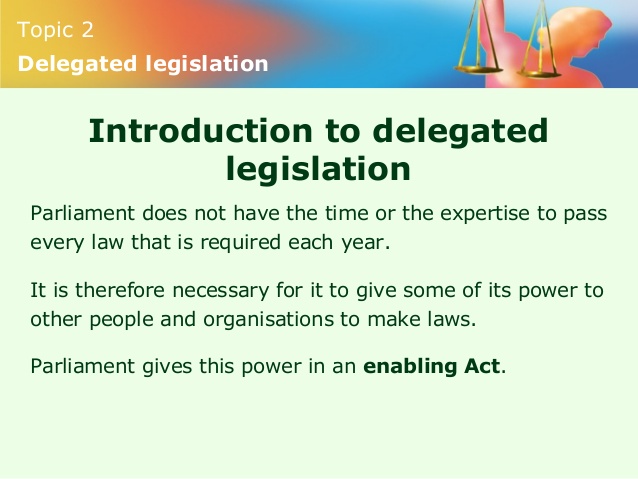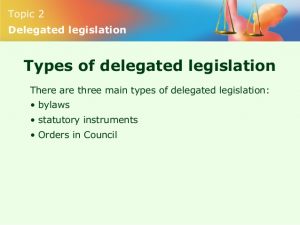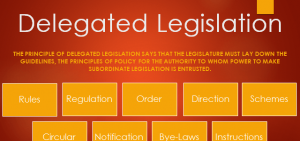Delegated legislation
Delegated legislation is allowing bodies below the parliament to pass their own legislation. There are three main forms of delegated legislation they are, statutory instruments, by-laws and Orders in Council. Statutory instruments are constructed by the Government departments. For example, the Parent Act permit’s the parliament about how legislation can be written and handle with. They are also engaged in the other Commonwealth countries other than the UK such as Canada. The Proclamation of the Queen of Canada was brought into impact and introduced the Constitution Act 1982 which is UK is known as the Canada Actj 1982.
By-laws are created by the local authorities which ’have to be approved by the central Government’. For example, the smoking ban in public areas in London is a by law because other local authorities can apply these regulations about public attitudes on their assertion. Orders in Council are made by the government in an emergency, they are rafted by the concerning Government departments, approved by the Privacy Council and signed by the Queen. It is exceedingly important as it can affect many individuals, moreover Orders in Council could have been used during the seventh of July 2005 London bombings.
Delegated Legislation is deemed necessary for a number of reasons. Firstly, the parliament does not have the time to deliberate and debate every detail of complicated rules. Delegated legislation allows laws to be made quickly than Parliament as Parliament does not sit all the time and its procedure is rather slow because each Bill has to pass through all the stages. Another reason why delegated legislation is necessary is because MP’s do not frequently have the technical ability required.
Knowledge is required for example, at work for safety or when carrying out difficult taxation proposals, this is where delegated legislation can use their professionals in their favoured topics. Furthermore, for the local individuals it is vital that they recognise and take into account their needs. The democratic bodies have important powers to make delegated legislation . It can also be easily revoked so that legislation can be updated frequently for the such as concerning welfare benefits. Delegated legislation comes into great benefit when problems occur concerning the result of a statue.
There are a numerous critical reasons why it is necessary to have control over delegated legislation . Taking into account that delegated legislation is made by elected representatives, individuals have the aptitude to pass delegated legislation. Without control, there would be many absurd laws such as the ‘Strickland V Hayes Borough Council (1986)’. In this case, a by-law prohibited an indecent song which was held by the court as invalid. There are a number of cases where delegated legislation has come into power to abstain damage to authorities for example, the National Union of Teachers (2000). A criticism of delegated legislation is that too often power is given to other individuals rather than those who had power at the beginning. Also, with access delegated legislation critics have argued that there is overuse in the law.
Delegated legislation is controlled by the Parliament and the judiciary. Overall, the Parliament has control along with statutory committees who take into account the delegated powers made by a Bill. Using the negative resolution procedure statutory instruments can become legislation in either two ways. One of the ways it commences is when after the statutory instruments is written, it is shown to Parliament. However, if after forty days there are no counter arguments it instantly becomes law, if there is some concern then it is debated upon.
The other procedure is more oppressive as the Parliament does not amend any statutory instruments in fact only one out of ten instruments are passed under this procedure. This is because this situation has to be debated upon and by both Houses within twenty-eight to forty days. There are disadvantages to this as it may take longer for Parliament to raise any issues especially from other parties. In reality, it’s highly unlikely for the Government not to reach a majority when so many votes are taken into account.
The Joints Committee gas control over statutory instruments paying attention to delegated legislation being created. Special further consideration is made before the committee step of the Bill and is reported to each House. If though the committee does not consider the virtues of delegated legislation, it is then the House of Lords Merits of statutory instruments committee’s responsibility. With both procedures time is an important issue and in this case a huge disadvantage of the Joints Committee is that the committee may not even get discussing any legislation. However, advantages of the affirmative resolution procedure includes attracting the publics view and opinions, allows both Houses to advocate and is put before the parliament. There are two grounds of ultra vires procedure, the definition ‘ultra vires’ refers to ‘beyond the powers’ there are two types, procedural and substantive.
Delegated legislation may be controlled by the judiciary and can be illustrated by using cases such as the Aylesbury Mushroom case (1927), Strickland V Hayes Borough Council (1896) and Attorney-General V Fulham Cooperation (1921). In the Aylesbury Mushroom case (1927) the Minister didn’t ask the mushroom Growers association when delegated legislation relating to them was made. This case shows how delegated legislation is challenged by the courts, the Training Board which was used for land-workers in this case was held as invalid by the courts but valid for everyone else who had been consulted. This demonstrates that a Minister should always abide by the rules in the Enabling Act and it is useful to have delegated legislation.
The substance ultra vires demonstrates that when a decision is made outside the powers on the basis conferred by a decision maker, under the enabling act. The case relating to this occurred in the ‘Customs and Excise Commissioners V Cure & Deely Ltd (1962) where the power of the commissioners to make delegated legislation under the finance act no. 2 (1940) were challenged. The Act allowed them to create rules ‘for any matter for which provision appears to them necessary for the purpose of giving effect to the Act. The High Court concluded that it gave Government departments far too much power which was beyond Parliament. This is because their role was to collect the tax due only.
The Parliamentary Sovereignty is a principle of the UK constitution. This means that it can make and demolish any law with legal official permission to do so in this country including delegated legislation. It is important because Parliament can pass laws that future Parliaments cannot amend.
Judges use various methods to interpret law, using constriction. There are three different types which include the Literal rule, Golden rule and Mischeif rule.
The literal rule states that words in a statue should be in their ordinary and natural meaning, if the words of a statue are vibrant they must be clarified with the ordinary meaning; it does not matter how absurd the end result is. An example of the literal rule was used in ‘Whitley V Chappell (1868) where the court held that Whitley could not ‘find guilty of impersonating any person entitled to vote’ at an election. This is because he impersonated a dead person who clearly was not entitled to vote and physically cannot do! The literal rule associates two rules the noscitur a socils rule and the ejcisdene generis rule.
The first means that the meaning of the word or phrase must be arbitrated by its context. For example, the word ‘switch’ has no real meaning on it’s own, but with its meaning it becomes more understandable and vivid when its brought into context. E.g. ’switch on the light’ . The ejusdem generis rule, which is the when the meaning of any general term is dependent on any specific terms which precedes it. For example, in the Sunday Observance Act 1677 it included that ’no tradesman, artificer, workman, labourer or other person whatsoever shall do or exercise any worldly labour…’. The phrase ’or other persons whatsoever’ is a phrase which is too broad in this context and almost impossible to predict. It was found that an estate agent was not within the exception.
The advantages of the literal rule is that it respects parliamentary sovereignty, where those who are elected for the job are left for law-making only. Moreover, because the statue is kept in their ordinary and natural meaning it makes the law more accurate and reliable for when lawyers want to advise their clients. The disadvantages of the literal rule is that is can lead to a bised and absurd conclusion like in the ‘Whitley V Chappell’ case, where voting for a dead individual the defendant was not charged as guilty. In another case ‘London and North Eastern Railway Co. V Bernman’ demonstrates the discrimination produced. As it shows the type of work done doesn’t change the amount of danger the workers were exposed to. In addition, as we looked at the different types of rules it is still difficult to define certain terms, when brought into context.
The Golden Rule, defined by Lord Wensleydale in Grey V Pearson (1857) is the elaboration, expansion and equanimity of the literal rule. If the literal rule gives an absurd outcome or conclusion then the Judge can replace another meaning in the ’light of the statute’. The Golden Rule can be viewed in two ways, firstly by constricting the meaning and as a results clarifying the meaning of the word which will not lead to incongruity. For example in the ’Alder V George (1964)’ case the defendant had been charged under section three of the official Secrets Act 1920 obstructing a member of the armed forces which is an offence ‘in the vicinity of any prohibited place’.
The individual argued that the natural meaning of ‘in the vicinity’ meant near to, whereas the defendant performed the obstruction within the area. The decision was made that ‘in the vicinity’ could only indeed be interpreted as meaning near to therefore the court didn’t restrict the literal phrase of the Act and the defendant was found guilty. The second way the golden rule can be viewed is by using the wider approach, which is used to avoid absurd outcomes to rules even if the word has only one meaning.
To illustrate, the Re Sigworth (1935) case which described a son murdering his mother. The mother had not made her will and the Administration of Justice Act 1925 which stated ‘a person, could not inherit the estate of the decease if they had murdered that person otherwise the murderer would benefit from his/her crime’ The court held that the son could not benefit from the crime even though the word ‘issue’ had one literal meaning in the Act.
Therefore the golden rule was used to avoid the abhorrent situation of the son inheriting. The advantages of the golden rule is that it allows Parliament to choose the most suitable word which will fit appropriately preventing any absurdity caused by the literal rule. The disadvantage of the golden rule is that it is used in infrequent situations perhaps this is because the Law Commission noted in 1969 that it granted no clear meaning of an ‘absurd result’.
The mischief rule was introduced in the sixteenth century in the ‘Heydons case (1584)’ and provides that the courts should consider three factors when deciding the true meaning of the statute. These factors include what was the common law before the statute was passed , what ‘mischief’ the statute was trying to cure and what remedy the Parliament was trying to provide. There are many cases which illustrate the mischief rule such as the ‘Smith V Hughes’ (1960) case where six women appealed against this as they were sitting in a house on the ground floor apparently attracting men by tapping on the window as they were walking by.
The Streets Offences Act 1959 claimed that it is a criminal offence for a prostitute to solicit herself in public on the street or a public place to customers. But as the prostitute was not actually on the street the judge decided that the women were guilty as they were still attracting the men. Also, the judge decided that individuals who do not walk on the street without being solicited should also be authorised in the Act.
Moreover, the ‘Royal College of Nursing V DHSS’ 1981 case used the mischief rule when the wording used in the ‘The Abortion Act’ 1976 which stated that abortion can only be performed by a ‘registered medical practioner’. But in 1972, nine years before, surgical abortions were mainly replaced by drug induced ones, this lead to the second stage of the procedure which included the patient attached to a drip, conducted by a general doctor.
The court had to decide whether this method was illegal or not, the House of Lords claimed that the mischief, which the Act preferred to cure was too vague from the previous law which lead to many women performing abortion acts on themselves alarmingly. Eventually they decided that abortion acts should be carried out by a professionally skilled hygienic nurse from the hospital. The advantage of the mischief rule allows a ‘rather more satisfactory approach’ described by the Law Commission in 1969.
As a consequence it’s a more flexible approach letting judges fill in the gaps in the law at the appropriate places making it accomplished when looking back. However the disadvantages is that when judges do look back and try to fill in the gaps, they often fill accordingly to their own perspective therefore lawyers tend to struggle when advising their clients as its rarely used.
The purposive approach known as the ‘preferred approach’ looks at what the Parliament is trying to achieve, clarifying that the interpretation of the law is correct searching for the purpose of the law. Judges use laws from the past to fill the gaps in preferred spaces. Lord Dennings stated his views in ’Magor and St Mellons Rural District Council V Newport Corporation (1952) ‘We do not sit here to pull the language of Parliament to pieces and make nonsense of it…we do this better by filling in the gaps and making sense of the enactment than by opening it up to destructive analysis’ .
This statement was strongly criticised by Lord Scarman sharing his views that ‘we are governed by Parliaments intentions but by governments enactments. Already, we can see a friction being caused by the two judges which can cause a major issue when analysing the purposive approach. Legislation can be interpreted using the purposive approach explained in the ‘R (Quintavalle) V Secretary of State for Health (2003)’ where the House of Lords were asked to interpret the Human Fertilisation and Embryology Act 1990. (p57).
Their use of embryos was regulated by the Human Fertilisation and Embryology Authority (HFEA), scientist later discovered a new cloning method where replacing the nucleus of an egg with a cell from another individual instead of been created by a fertilised egg. The Government released a statement saying that medical research involving cloned embryos did fall within the Act and could be regulated by the HFEA. However, Pro-life Alliance opposed to this and wanted a declaration of the courts that HFEA was performing outside statutory powers.
As a result, the House of Lords gave the Act a purposive interpretation to show the true aims of the Parliament and they could not have intended to prevent cloned embryos from being controlled by the HFEA. This illustrates that the advantage of the purposive approach is that it allows any new laws to take place as with new technology old laws will eventually be outdated and need replacing. On the other hand, it may make people feel uneasy that judges, without being elected are creating laws when they wish to rather than using the words conducted by the Parliament.
So far I have expressed the four different ways in which judges take to statutory interpretation judges may also use internal aids which are found within the piece of legislation. The literal and the golden rule both lead the judge to internal aid and help the judges understand the statute more clearly. The internal aids include the long and short title of the Act or the subheadings within it. The explanatory notes defines the sections, the rules of language as mentioned earlier including the ejusdem generis and the noscitur a sociis.
Presumptions are also used to interpret legislation such as the following, the legislature doesn’t take out any issues from the jurisdiction of the courts and laws which introduce crimes should be favoured for the citizen where uncertainty is shown. In the case ‘L’Office Cherifen des Phosphates Unitramp SA V Yamashita-Shinnihon Steamship Co Ltd 1994’ disturbed the presumption against the retrospective consequence. It pointed out the rule of ‘simple fairness’, if the House Of Lords had read the relevant statute as imposing the suggested degree of retrospective effect would the result be so discriminative that Parliament could not have intended it. Just as their words may have suggested a retrospective effect? Judges would have had to look at a number of issues including the nature of the rights affected, the lucidity of the words and the background of the law.
External aids include judges using things outside the statute to help them understand the meaning of it clearly. Using the historical setting, dictionaries, reports, treaties and Hansard. The historical setting may be considered when interpreting legislation along with dictionaries to find the meaning of legal terms. Reports may be lead by a Royal Commission, the Law Commission or another member of the advisory committee. In ’Black Clawson International Ltd V Paperiwerke Waldhof- Aschaffenbury AG 1975’ the report was considered and was indicated by the House of Lords, that the original reports would be considered as evidence of the pre-existing state of the law. Treaties and international conventions are considered when believing the presumption that Parliament do not create laws in the same way that the UK would be. Hansard




